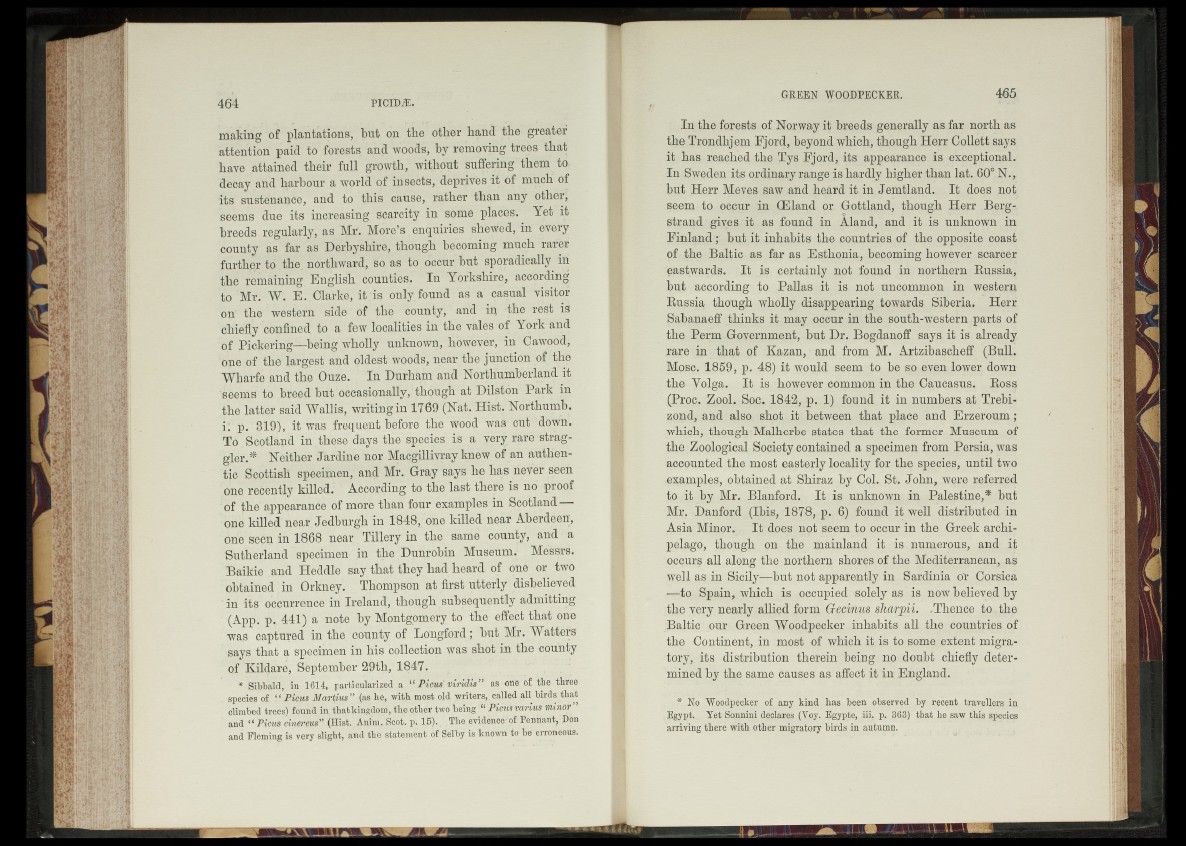
making of plantations, but on the other hand the greater
attention paid to forests and woods, by removing trees that
have attained their full growth, without suffering them to
decay and harbour a world of insects, deprives it of much of
its sustenance, and to this cause, rather than any other,
seems due its increasing scarcity in some places. Yet it
breeds regularly, as Mr. More’s enquiries shewed, in every
county as far as Derbyshire, though becoming much rarer
further to the northward, so as to occur but sporadically in
the remaining English counties. In Yorkshire, according
to Mr. W. E. Clarke, it is only found as a casual visitor
on the western side of the county, and in the rest is
chiefly confined to a few localities in the vales of York and
of Pickering—being wholly unknown, however, in Cawood,
one of the largest and oldest woods, near the junction of the
Wharfe and the Ouze. In Durham and Northumberland it
seems to breed but occasionally, though at Dilston Park in
the latter said Wallis, writing in 1769 (Nat. Hist. Northumb.
i: p. 319), it was frequent before the wood was cut down-.
To Scotland in these days the species is a very rare straggler.*
Neither Jardine nor Macgillivray knew of an authentic
Scottish specimen, and Mr. Gray says he has never seen
one recently killed. According to the last there is no proof
of the appearance of more than four examples in Scotland—
one killed near Jedburgh in 1848, one killed near Aberdeen;,
one seen in 1868 near Tillery in the same county, and a
Sutherland specimen in the Dunrobin Museum. Messrs.
Baikie and Heddle say that they had heard of one or two
obtained in Orkney. Thompson at first utterly disbelieved
in its occurrence in Ireland, though subsequently admitting
(App. p. 441) a note by Montgomery to the effect that one
was captured in the county of Longford; but Mr. Watters
says that a specimen in his collection was shot in the county
of Kildare, September 29th, 1847.
* Sibbald, in 1614, particularized a “ Ficus viridis” as one of the three
species of “ Picus Martins” (as he, with most old writers,,called all birds that
climbed trees) found in that kingdom, the other two being “ Picus varius minor”
and “ Picus cinereus” (Hist. Anita, Scot. p. 15)., The evidence of Pennant, Don
and Fleming is very slight, and the statement of Selby is known to be erroneous.
In the forests of Norway it breeds generally as far north as
the Trondhjem Fjord, beyond which, though Herr Collett says
it has reached the Tys Fjord, its appearance is exceptional.
In Sweden its ordinary range is hardly higher than lat. 60° N.,
but Herr Meves saw and heard it in Jemtland. It does not
seem to occur in (Eland or Gottland, though Herr Berg-
strand gives it as found in Aland, and it is unknown in
Finland; but it inhabits the countries of the opposite coast
of the Baltic as far as Esthonia, becoming however scarcer
eastwards. It is certainly not found in northern Russia,
but according to Pallas it is not uncommon in western
Russia though wholly disappearing towards Siberia. Herr
Sabanaeff thinks it may occur in the south-western parts of
the Perm Government, but Dr. Bogdanoff says it is already
rare in that of Kazan, and from M. Artzibascheff (Bull.
Mosc. 1859, p. 48) it would seem to be so even lower down
the Yolga. It is however common in the Caucasus. Ross
(Proc. Zool. Soc. 1842, p. 1) found it in numbers at Trebi-
zond, and also shot it between that place and Erzeroum ;
which, though Malherbe states that the former Museum of
the Zoological Society contained a specimen from Persia, was
accounted the most easterly locality for the species, until two
examples, obtained at Shiraz by Col. St. John, were referred
to it by Mr. Blanford. It is unknown in Palestine,* but
Mr. Danford (Ibis, 1878, p. 6) found it well distributed in
Asia Minor. It does not seem to occur in the Greek archipelago,
though on the mainland it is numerous, and it
occurs all along the northern shores of the Mediterranean, as
well as in Sicily—but not apparently in Sardinia or Corsica
■—to Spain, which is occupied solely as is now believed by
the very nearly allied form Gecinus sharpii. /Thence to the
Baltic our Green "Woodpecker inhabits all the countries of
the Continent, in most of which it is to some extent migratory,
its distribution therein being no doubt chiefly determined
by the same causes as affect it in England.
* No Woodpecker of any kind has been observed by recent travellers in
Egypt. Yet Sonnini declares (Yoy. Egypte, iii. p. 363) that he saw this species
arriving there with other migratory birds in autumn.